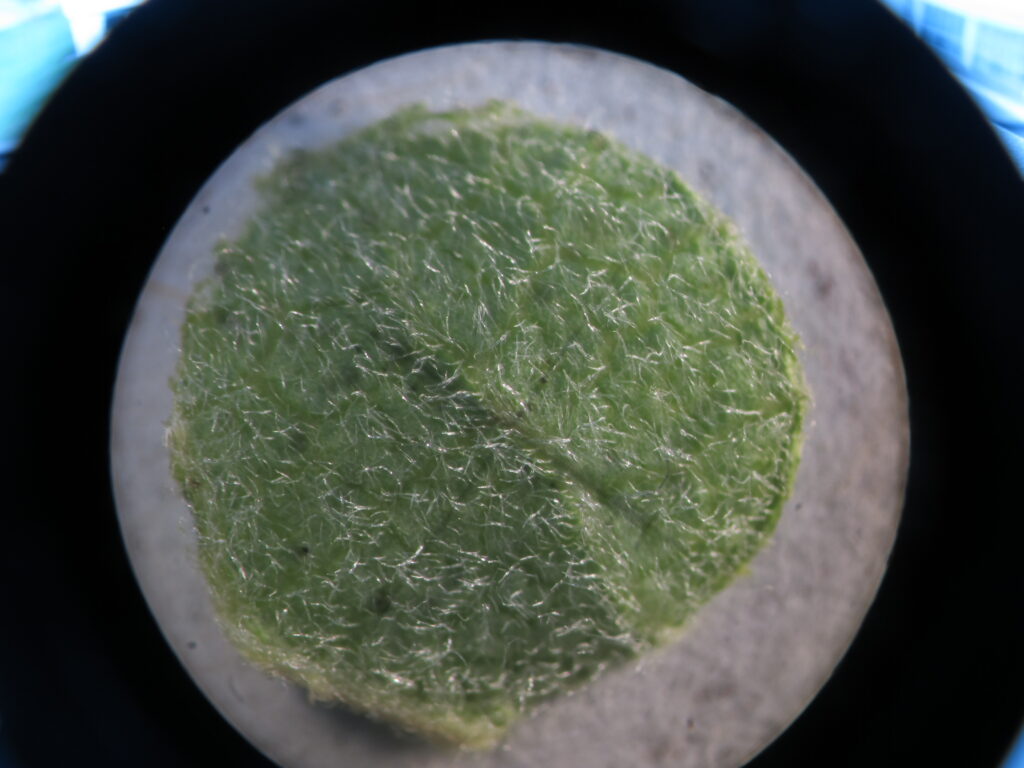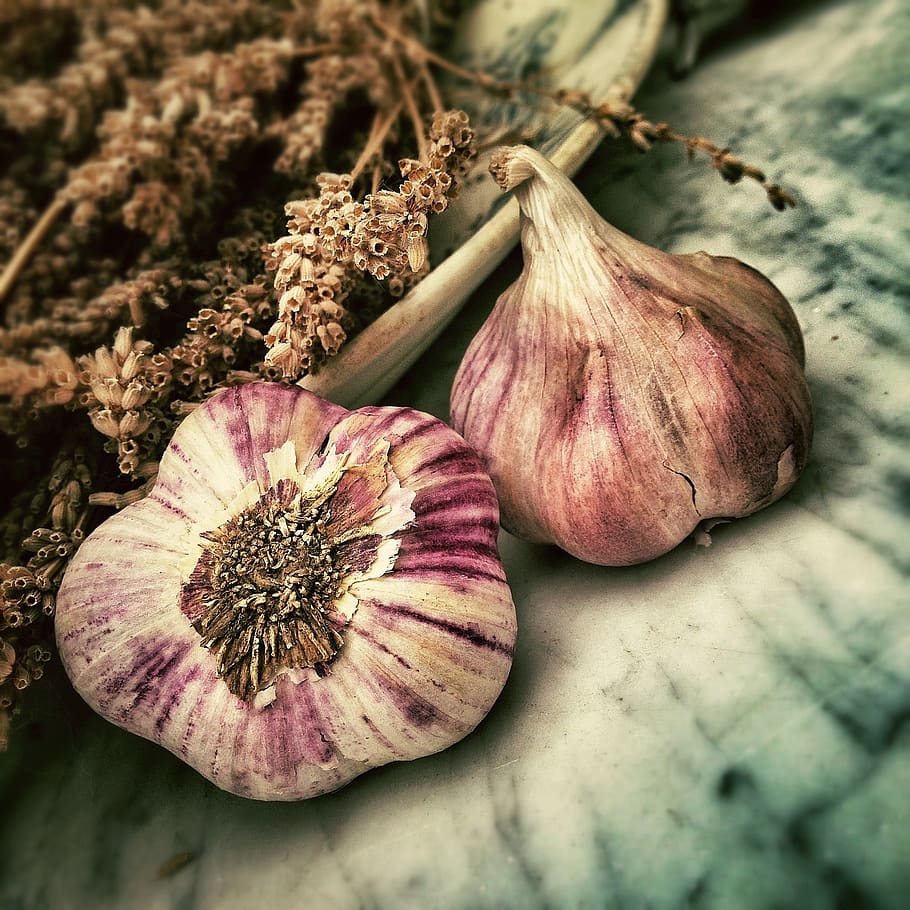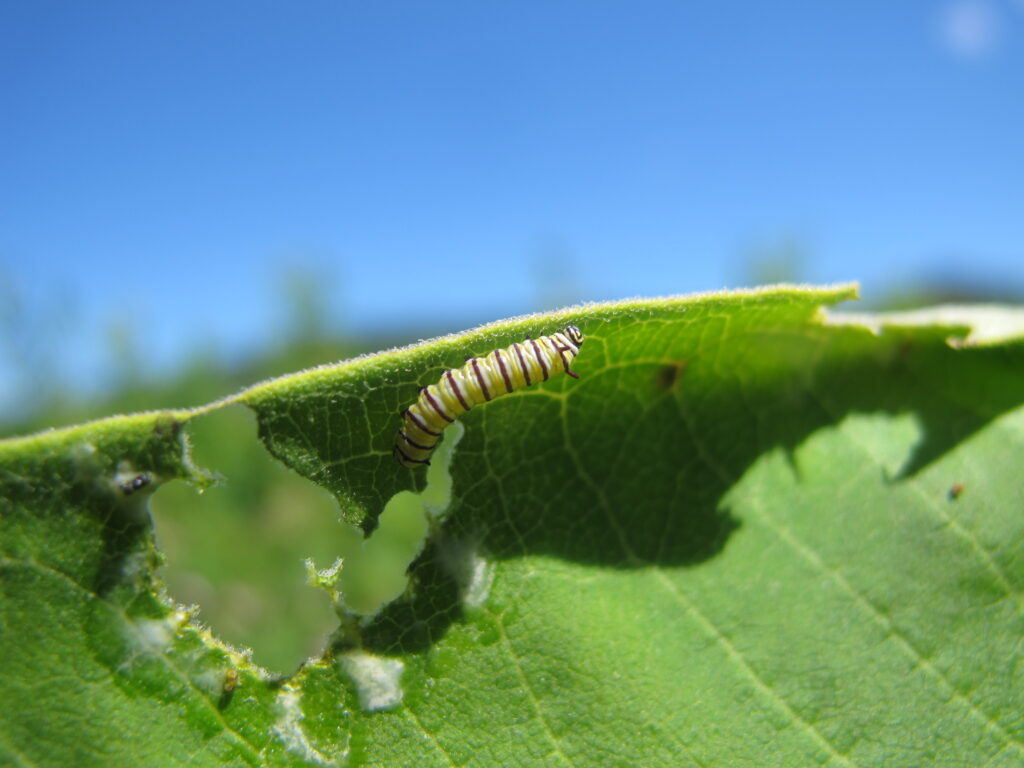Plants are… cool. Super cool. Plants don’t move (well, not a lot and generally not very fast or far), so they’re easy to overlook, but they tackle all kinds of challenges with wild adaptations. (Plants DO move, though! For example, here’s a video of vine slowly “feeling” for something to twine around as it grows!) Personally, I’m most fascinated by plant defenses.
Like unfortunate characters in a grotesque horror film, plants are rooted in the ground as herbivores eat them alive. Rather than fleeing, as a gazelle might dash away from a cheetah, plants instead must rely on defense strategies survive. The ways they do this are varied, and wild.
Plants may have thorns, to defend against smaller hebivores (like insects!) they may have tiny defensive hairs (called trichomes). Some plants even have sharp-sickle-like blades on the end of their trichomes that can slice up the soft bellies of caterpillars. I would call this the most metal plant defense ever (🌱 ☠️🤘), but some plants literally absorb heavy metals (like selenium) from the soil, and use it to make their leaves toxic.

Plants sometimes have defensive saps that can trap insects, or glue their mouthparts together. This is the sticky white latex that milkweed plants exude if you break them, or that dandelions spit out if you break off the flower stem, and if you watch carefully when you cut into a yam, you’ll see a little bit of it coming out of that.
One of my favorites are bodyguards. Some plants will provide rewards (often from “extra floral nectaries“, which produce snacks that aren’t a part of a flower) to predatory insects that in turn tend to hunt down the herbivorous insects that are trying to chow down on the plants. There are some extreme cases of this – most species of acacia trees actually have modified thorns that serve as homes for ants, and specialized species of ants will live in, feed from, and protect these acacia trees from all intruders (even elephants).

One of the prevalent types of defenses are chemicals that make the plants toxic or undesirable to herbivores, especially insects. In fact, we are surrounded by these! The spicy flavor of mustard and mustard greens? Plant defense. That delicious (but potent) garlic flavor? Plant defense. Mint, pepper, arugula, rosemary – if a food is spicy or has a very strong flavor, that was probably originally a defense. These defenses evolved over millions of years, but typically the plants were selected to defend against insects – flavors that you and I might enjoy can be very noxious to bugs. (But also, the plants that we’ve bred to be crops are often much milder and more pleasant to eat than their more defended, wild relatives – wild mustard is MUCH more spicy than the mustard greens you can find in a grocery store).
I also start every morning by drinking a nice piping cup of plant defenses. That’s right! Caffeine is a plant defense – it might give me energy, but it can be lethal to insects, particularly if all they eat is coffee seeds (if all I ate was coffee, I would also probably not be very healthy). We also have a lot of drugs – good and bad – that either are actually plant defenses that we extract (like the opiates for morphine, which come from poppy plants; or the nicotine in tobacco, which comes from the tobacco plant), or we developed based on defense compounds (like the active ingredient in aspirin, which is related to a compound in willow trees; or the cardiac glycosides we use to treat heart conditions, which were developed from milkweed plants and foxglove plants). In general, plants have spent millions upon millions of years evolving toxins that modify the way animal bodies work — with careful experimenting, scientists and doctors have developed ways of using that to treat illness and injury.

I could keep going on plant defenses (the chameleon vine will change its leaf shape to blend in with the surrounding plants! Some plants have “fake” damage patterns, which may convince herbivores that they’re too damaged to bother eating!), but I think I’ve made my point. Plants have a wide range of fascinating tools to avoid being eaten.
(To be clear, plant defenses are a separate thing from carnivorous plants – those plants live in places with very little nitrogen and other nutrients, and so they have evolved to catch and digest insects. Which is also amazing (like, mindboggling!), but while almost every plant employs defenses, only about 1000 species are truly carnivorous.)
Okay, so what do *I* actually do?
I love sharing facts about plants and plant defenses, but the stuff I talked about above has already been discovered. So what is my work?
Well, most plants employ a few different defense traits simultaneously. It’s not enough to be toxic – they might also have defensive hairs. Or maybe they’re really low in nutrition, and have integrated silica (basically glass) into their leaves to wear down insect mouths. But why use more than one defense? In our day to day life, we tend to think about specialization. On the football field, the quarterback and the linemen do very different jobs. The quarterback should be the person on the team best able to throw the ball, and he or she is in a position where that’s pretty much all they do. The lineman is blocking the opponents – if the quarterback is doing that, something went wrong.
And yet plants are usually a lineman AND a quarterback. Or a car mechanic AND an astronaut. Or a… you get the idea. Ecologists have a lot of ideas of why it might be beneficial for plants to use multiple defenses — and which defenses they should combine — but it has been hard to test these ideas. That’s what I’ve been working on.
I carried out a series of experiments on common milkweed plants, looking at how well they fended off Monarch Butterfly caterpillars, and the larvae of swamp milkweed beetles (the little orange guys on the banner up top – and the leaf is from a common milkweed plant). People had hypothesized several things, but the most exciting one was the idea that milkweed defenses might synergize.

Milkweed plants have several defenses, including small defensive hairs and latex. When a monarch caterpillars first hatches, it’s absolutely tiny. It crawls out onto a leaf and carefully chews down every hair in a little circular patch. And then only once it’s done that does it bite down into the leaf. And this point… BAM! Biting into the leaf release a spray of sticky latex, which acts as a quick-drying cement, and can glue the caterpillar to the leaf and kill it. So the caterpillar must struggle free of the latex. And ecologists think that it’s harder for these hungry, newly hatched caterpillars to do that if they’re tired and hungry from chewing through those defensive hairs. So if a plant has more hairs, the hairs might make the latex even more effective – if the plant is using one, they should use the other!
At least, that’s the idea. I’m still analyzing the data, and I’ll let you know what I find. There were several other of these hypothesized ideas that I was testing, but they’re a little harder to explain.
The other thing I’ve worked on is putting together a general math model and simulation to represent a general, hypothetical plant, and a general, hypothetical insect. The idea with this project is to build an intuition for when (and why) certain types of defenses should be optimal for plants. This is also in progress, but I’m very excited about it. The basic idea is that the math model and simulation is almost like a computer game, that the computer plays against itself. I can choose the rules that the insect and plant follow, and I look at how the plant does based on the defense strategies it follows. When the plant does well, that suggests the strategy might be a good idea. By basing the overall “game” on existing ideas of how plants and insects work, it hopefully is capturing realistic dynamics. And by basing the specific numbers – how fast the insect grows, how toxic the plant is, etc. – on past studies, my results are hopefully representative of actual plants and insects.

